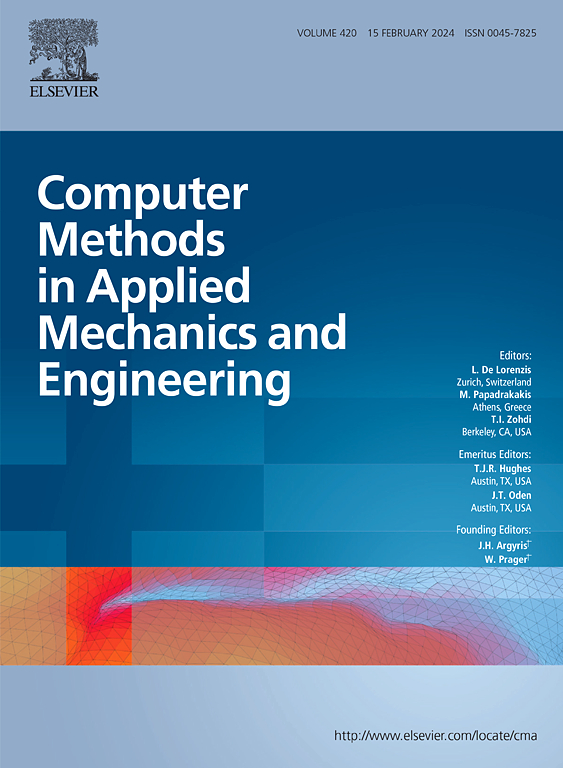A physics-informed 3D surrogate model for elastic fields in polycrystals
IF 6.9
1区 工程技术
Q1 ENGINEERING, MULTIDISCIPLINARY
Computer Methods in Applied Mechanics and Engineering
Pub Date : 2025-04-01
DOI:10.1016/j.cma.2025.117944
引用次数: 0
Abstract
We develop a physics-informed neural network pipeline for solving linear elastic micromechanics in three dimensions, on a statistical volume element (SVE) of a polycrystalline material with periodic geometry. The presented approach combines a convolutional neural network containing residual connections with physics-informed non-trainable layers. The latter are introduced to enforce the strain field admissibility and the constitutive law in a way consistent with so-called fast Fourier transform (FFT) algorithms. More precisely, differential operators are discretized by finite differences in accordance with the Green operator used in FFT computations and treated as convolutions with fixed kernels. The deterministic relationship between crystalline orientations and stiffness tensors is transferred to the network by an additional non-trainable layer. A loss function dependent on the divergence of the predicted stress field allows for updating the neural network’s parameters without further supervision from ground truth data. The surrogate model is trained on untextured synthetic polycrystalline SVEs with periodic boundary conditions, realized from a stochastic 3D microstructure model based on random tessellations. Once trained, the network is able to predict the periodic part of the displacement field from the crystalline orientation field (represented as unit quaternions) of an SVE. The proposed self-supervised pipeline is compared to a similar one trained with a data-driven loss function instead. Further, the accuracy of both models is analyzed by applying them to microstructures larger than the training inputs, as well as to SVEs generated by the stochastic 3D microstructure model, utilizing various different parameters. We find that the self-supervised pipeline yields more accurate predictions than the data-driven one, at the expense of a longer training. Finally, we discuss how the trained surrogate model can be used to solve certain inverse problems on polycrystalline domains by gradient descent.
多晶体弹性场的物理三维替代模型
我们开发了一个物理信息的神经网络管道,用于求解具有周期几何形状的多晶材料的统计体积元(SVE)的三维线弹性微力学。该方法将包含残差连接的卷积神经网络与物理信息的不可训练层相结合。后者被引入以一种与所谓的快速傅立叶变换(FFT)算法一致的方式来强制应变场可容许性和本构律。更准确地说,微分算子按照FFT计算中使用的Green算子被有限差分离散,并被视为具有固定核的卷积。晶体取向和刚度张量之间的确定性关系通过附加的不可训练层传递到网络中。依赖于预测应力场散度的损失函数允许更新神经网络的参数,而无需进一步监督地面真实数据。该替代模型是在具有周期性边界条件的无纹理合成多晶sve上进行训练的,该模型是基于随机镶嵌的随机三维微观结构模型实现的。经过训练后,该网络能够从SVE的晶体取向场(表示为单位四元数)预测位移场的周期性部分。将提出的自监督管道与使用数据驱动损失函数训练的类似管道进行比较。此外,通过将这两种模型应用于大于训练输入的微观结构,以及使用各种不同参数的随机3D微观结构模型生成的SVEs,分析了两种模型的准确性。我们发现,自我监督的管道比数据驱动的管道产生更准确的预测,代价是更长的训练时间。最后,我们讨论了如何将训练好的代理模型用于梯度下降法求解多晶域上的某些逆问题。
本文章由计算机程序翻译,如有差异,请以英文原文为准。
求助全文
约1分钟内获得全文
求助全文
来源期刊
CiteScore
12.70
自引率
15.30%
发文量
719
审稿时长
44 days
期刊介绍:
Computer Methods in Applied Mechanics and Engineering stands as a cornerstone in the realm of computational science and engineering. With a history spanning over five decades, the journal has been a key platform for disseminating papers on advanced mathematical modeling and numerical solutions. Interdisciplinary in nature, these contributions encompass mechanics, mathematics, computer science, and various scientific disciplines. The journal welcomes a broad range of computational methods addressing the simulation, analysis, and design of complex physical problems, making it a vital resource for researchers in the field.

 求助内容:
求助内容: 应助结果提醒方式:
应助结果提醒方式:


